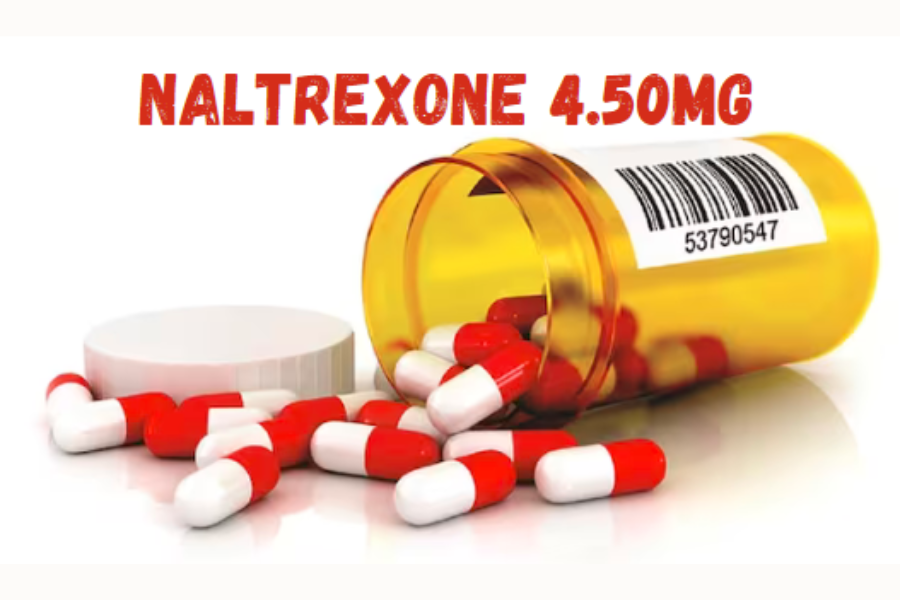Understanding “Naltrexone 4.50mg Extremely Tired” and Its Connection to Extreme Fatigue: A Comprehensive Guide
Experiencing overwhelming tiredness is a common concern among those taking “Naltrexone 4.50mg Extremely Tired”, especially at the 4.50mg dosage. While this medication is widely used to aid in addiction recovery, particularly for alcohol dependence, it’s important to recognize and understand the side effects that may accompany its use.
This guide delves into the connection between Naltrexone and fatigue, offering a deeper understanding of why this symptom might occur and how you can manage it effectively. Whether you’re currently using Naltrexone or considering it as part of your treatment, the insights provided here will help you navigate any feelings of exhaustion with confidence.
What is “Naltrexone 4.50mg Extremely Tired”?
Naltrexone is a medication commonly used to treat alcohol and opioid dependence. At a lower dose, such as 4.50mg, it is often prescribed off-label for various conditions, including fibromyalgia, chronic pain, and autoimmune diseases. This lower dose is typically referred to as Low Dose Naltrexone (LDN).
LDN has gained popularity for its potential to modulate the immune system and reduce inflammation, making it a promising option for managing chronic conditions. However, despite its benefits, many users report feeling extremely tired after starting this medication, a side effect that can be challenging to manage.
Why Might Naltrexone 4.50mg Cause Extreme Tiredness?
Naltrexone 4.5mg is commonly prescribed to help manage alcohol dependence and opioid addiction. This medication works by blocking opioid receptors in the brain, effectively reducing cravings and easing withdrawal symptoms associated with substance use.
However, some individuals may experience significant fatigue while taking Naltrexone at this dosage. This side effect could be linked to how the medication interacts with the body’s unique chemistry. It’s important to note that reactions to medications can vary greatly among individuals, meaning side effects like fatigue might manifest differently for each person.
In certain instances, this feeling of profound tiredness could also be connected to underlying health issues or the interaction with other medications being taken concurrently. It’s essential to monitor these factors closely to ensure overall well-being while using Naltrexone.
Understanding that fatigue may be directly related to this treatment allows individuals to make well-informed decisions regarding their ongoing health management.
How Does “Naltrexone 4.50mg Extremely Tired” Work?
Naltrexone functions by obstructing opioid receptors in the brain, effectively reducing cravings and easing withdrawal symptoms for individuals battling addiction. When administered in lower doses, Naltrexone is thought to have a positive impact on the immune system, potentially lowering inflammation levels. This effect may prove advantageous for those dealing with chronic pain and autoimmune disorders.
Naltrexone’s mechanism of action involves disrupting the endorphin system in the brain. Endorphins are natural chemicals that contribute to pain relief and feelings of pleasure. By blocking these receptors, Naltrexone diminishes the pleasurable effects associated with alcohol and opioids, thereby aiding individuals in their efforts to resist these substances.
Uses of “Naltrexone 4.50mg Extremely Tired”
Naltrexone 4.50mg is a medication primarily prescribed to support individuals battling alcohol dependence. By inhibiting the pleasurable effects of alcohol, it helps reduce cravings and encourages long-term sobriety.
In addition to its role in managing alcohol use disorders, “Naltrexone 4.50mg Extremely Tired” is also utilized in treating opioid addiction. The drug works by blocking the euphoria associated with opioid consumption, thereby aiding patients in resisting the urge to misuse these substances.
Moreover, Naltrexone is being explored for its potential benefits in addressing certain behavioral issues, particularly those related to food cravings and obesity. Preliminary studies suggest that it may play a role in regulating appetite and reducing tendencies toward binge eating.
For many patients, integrating Naltrexone into their recovery strategy marks a crucial step toward reclaiming control over their health and well-being. Due to its wide range of applications, Naltrexone is considered an essential component in various therapeutic settings.
Side Effects of Naltrexone 4.50mg
When taking Naltrexone 4.50mg, it’s crucial to be aware of possible side effects. A frequently reported issue by individuals is severe fatigue, which can greatly interfere with daily activities and may necessitate changes in one’s routine.
Other side effects that might occur include nausea, headaches, dizziness, or disruptions in sleep. These symptoms often arise as the body adjusts to the medication.
It’s important to keep track of how you feel after beginning this treatment. If the intense fatigue continues or worsens, it’s advisable to consult your healthcare provider. They can evaluate whether a dosage adjustment is necessary or if a different treatment option should be considered.
Being aware of these side effects helps patients make informed decisions about their health while using Naltrexone 4.50mg.
The Connection Between Naltrexone 4.50mg and Extreme Tiredness
While Naltrexone 4.50mg offers numerous benefits, some users report experiencing significant fatigue upon starting the medication. This side effect can be particularly disheartening for those who anticipated that Naltrexone would enhance their energy levels and help alleviate chronic tiredness. The precise reason behind this fatigue is not entirely clear, but several potential explanations could be at play.
One hypothesis is that Naltrexone might disrupt the endorphin system initially, causing a temporary imbalance that results in fatigue as the body adjusts to the new state. Another potential factor could be the drug’s influence on the immune system, which might lead to a temporary increase in inflammation or shift the body’s focus toward healing processes, thereby contributing to feelings of exhaustion.
Understanding these mechanisms is crucial for managing side effects effectively and optimizing the use of Naltrexone for individual health needs.
How to Take Naltrexone 4.50mg
Taking Naltrexone 4.50mg effectively requires strict adherence to your healthcare provider’s guidelines. This medication is generally administered in pill form, which supports daily use.
To ensure optimal results, it’s important to take Naltrexone at the same time every day. This routine helps maintain consistent levels of the medication in your body. If you miss a dose, do not attempt to compensate by taking an extra dose; simply continue with your next scheduled dose as usual.
Avoid consuming alcohol while using Naltrexone, as it can diminish the medication’s efficacy and potentially lead to increased side effects. Additionally, staying well-hydrated and maintaining a balanced diet can support your overall health during your treatment.
If you have any questions or need clarification regarding your medication or dosage, consult your healthcare provider. They are available to offer guidance and help address any concerns you may have during your treatment journey.
Dive into Fresh Perspectives: Cnbcblog.com
Benefits of Naltrexone 4.50mg for Alcoholism
Naltrexone 4.50mg offers notable benefits for individuals struggling with alcoholism. By blocking the pleasurable effects of alcohol, this medication significantly reduces cravings, allowing individuals to regain control over their drinking patterns.
One of the key advantages of Naltrexone is its impact on mood and mental clarity. Users often experience improved emotional stability, which helps them handle daily stressors without turning to alcohol.
Incorporating Naltrexone into a comprehensive treatment strategy can enhance participation in therapeutic activities and support groups. This medication supports a stronger dedication to recovery, creating a more attainable path to sobriety.
Moreover, Naltrexone encourages healthier lifestyle choices as individuals shift their focus from alcohol consumption to overall well-being. This transition not only fosters lasting behavioral changes but also contributes positively to overall health for those aiming to overcome addiction.
Precautions and Warnings
Before initiating Naltrexone 4.50 mg, it is crucial to consult with your healthcare provider. This medication has the potential to interact with other drugs, which may lead to unexpected side effects or diminish its effectiveness.Patients with liver conditions should exercise caution with Naltrexone, as it is metabolized by the liver. Regular monitoring of liver function may be necessary.
It is important to avoid alcohol consumption while on Naltrexone, as drinking alcohol can trigger severe withdrawal symptoms and undermine the effectiveness of the treatment.If you are pregnant or breastfeeding, discuss the potential risks of using Naltrexone with your healthcare provider to ensure the safety of both you and your baby.
Should you experience unusual fatigue or other concerning symptoms, seek medical attention promptly. Early intervention can help prevent complications and allow for the exploration of safer treatment alternatives.
Alternatives to Naltrexone 4.50mg for Alcohol Dependence
When exploring alternatives to Naltrexone 4.50mg for managing alcohol dependence, several effective options are available. One such option is Acamprosate, which aids in restoring the brain’s neurotransmitter balance that may be disrupted due to prolonged alcohol use.
Another treatment is Disulfiram, commonly known by the brand name Antabuse. This medication works by inducing adverse reactions when alcohol is consumed, thereby deterring individuals from drinking.
In addition to medication, counseling and behavioral therapies are crucial components of a comprehensive treatment plan. Cognitive Behavioral Therapy (CBT) is particularly beneficial, as it helps individuals alter negative thought patterns associated with alcohol consumption.
Support groups, such as Alcoholics Anonymous, provide valuable community support and shared experiences that many find instrumental in their recovery journey.
Furthermore, mindfulness practices and holistic approaches can also be advantageous for those seeking to reduce or eliminate alcohol intake. These methods focus on enhancing overall well-being, addressing both mental health and lifestyle factors.
Conclusion
Experiencing persistent fatigue while on Naltrexone 4.50 mg can be challenging, but understanding how this medication works and adopting effective management strategies can help alleviate this issue. Naltrexone is commonly used in the treatment of alcohol and opioid dependencies due to its ability to diminish cravings and support long-term recovery. Nonetheless, side effects such as extreme tiredness are possible and can vary based on individual responses to the drug and existing health conditions.
It’s essential to closely monitor any symptoms you experience and maintain an open line of communication with your healthcare provider. If fatigue becomes severe or continues unabated, your doctor might need to evaluate your treatment regimen or consider alternative therapies. Effective medication management requires balancing the therapeutic benefits with the potential side effects.
By staying well-informed and proactive about your treatment approach, you can better navigate the path to recovery and improve your overall well-being.
Keep up-to-date with breaking news and updates on Cnbcblog.com






